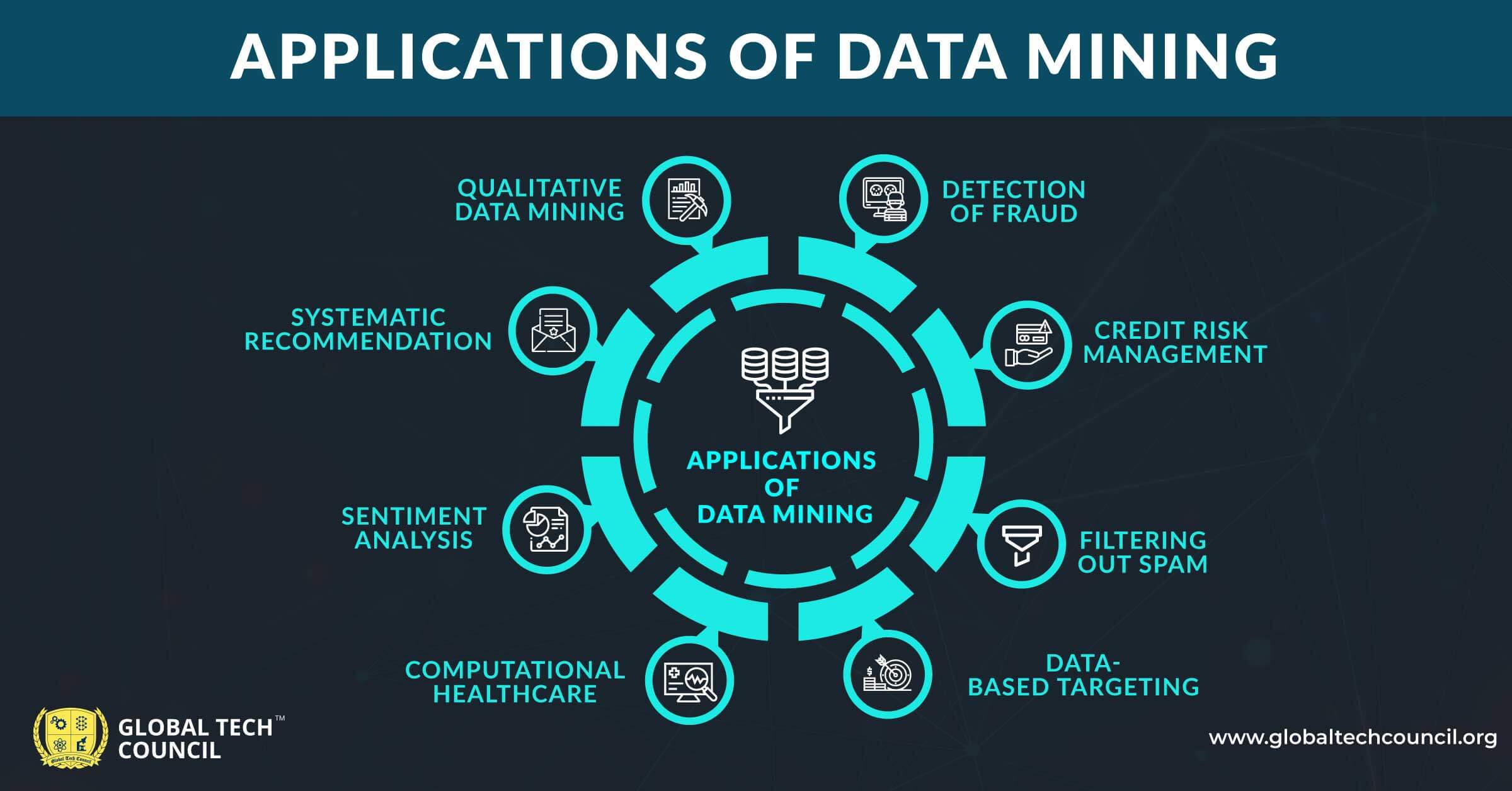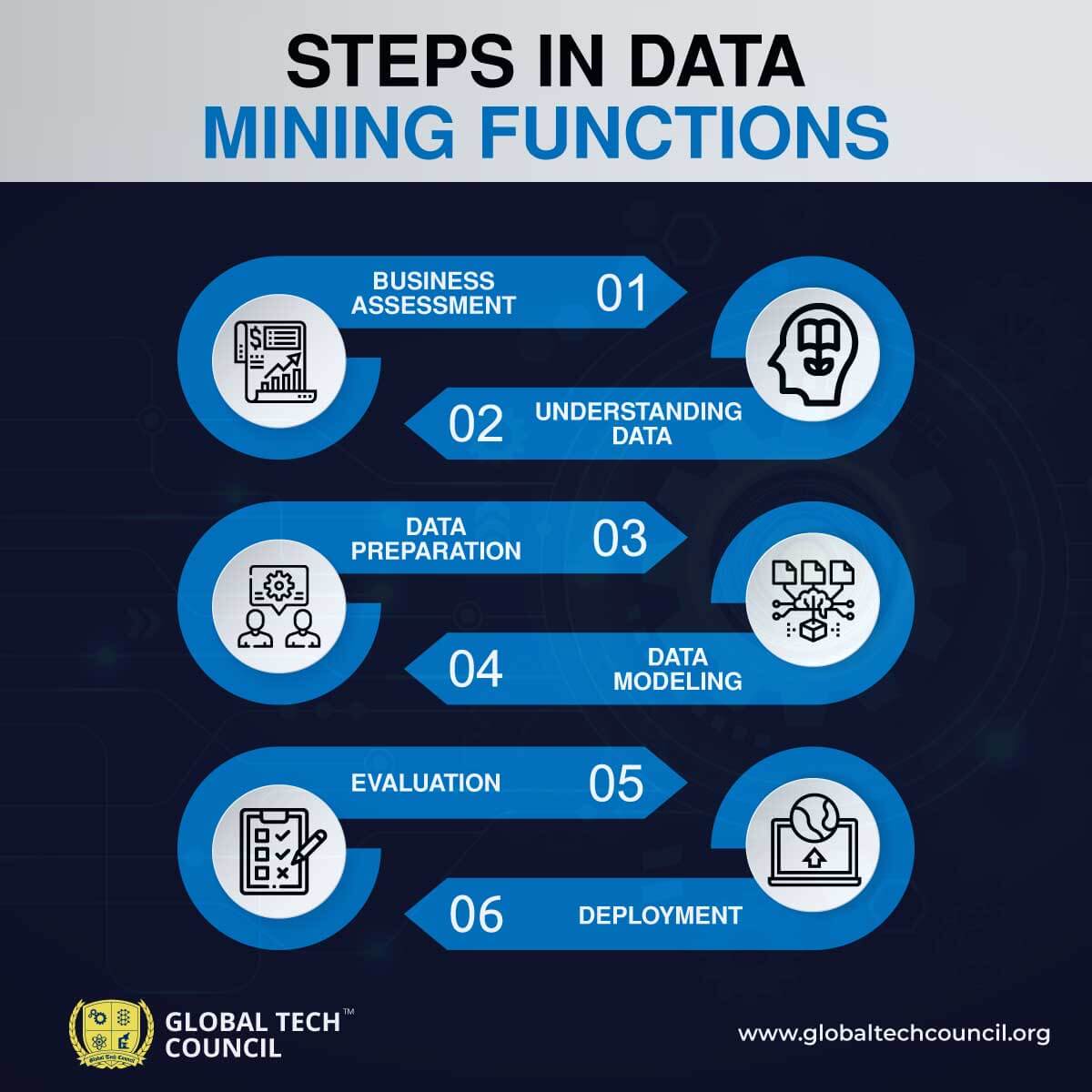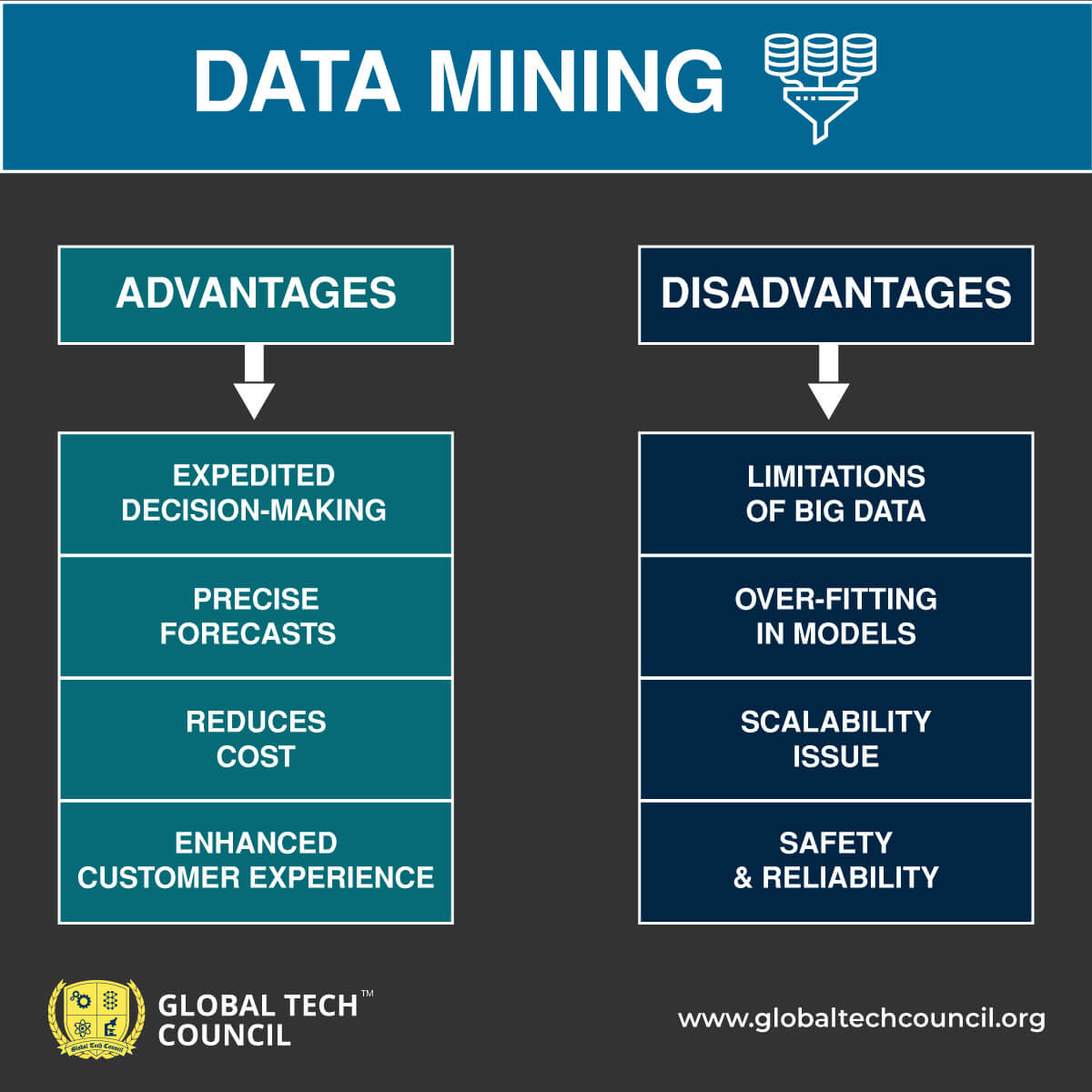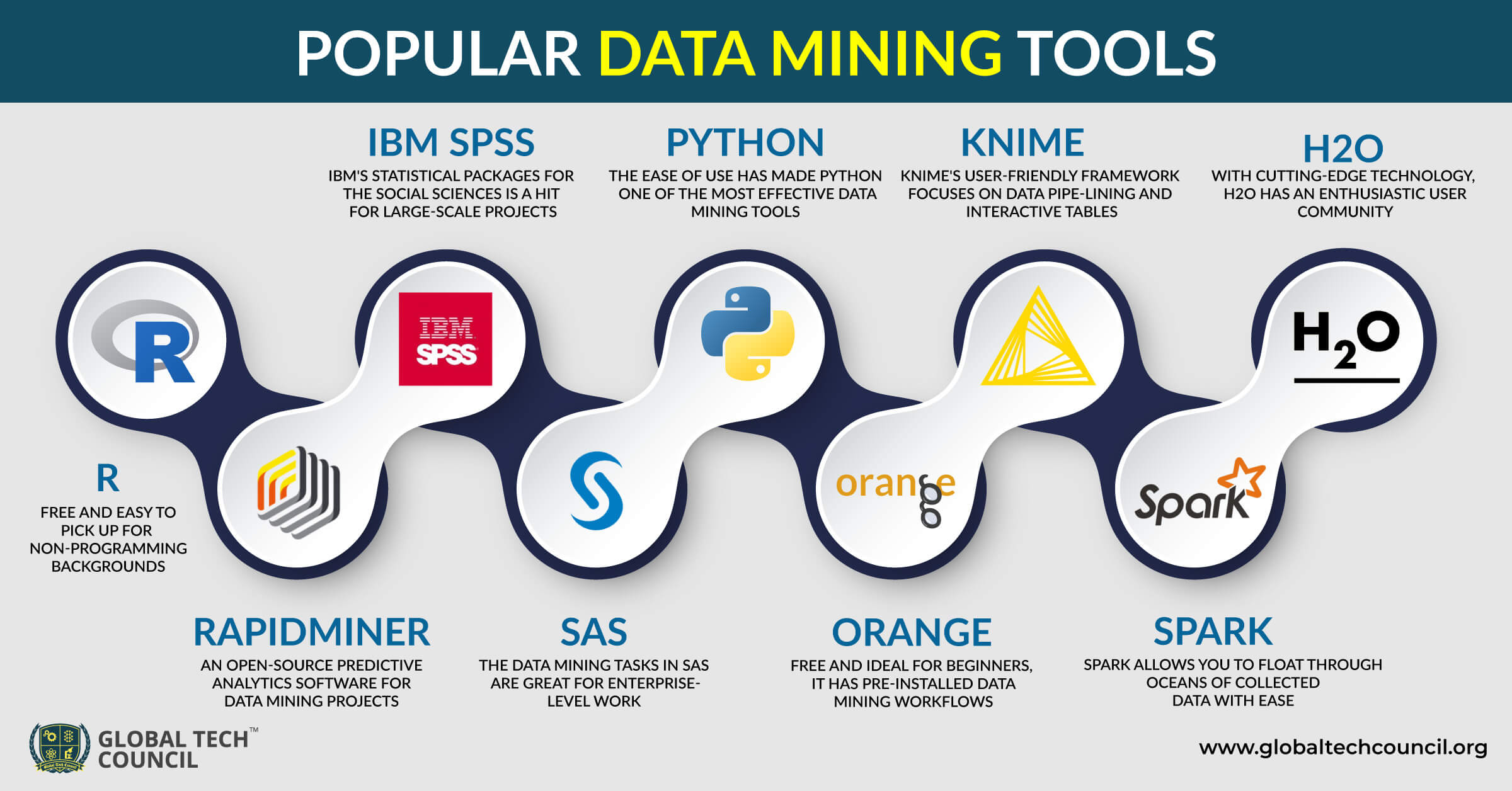Technology-driven applications currently reign our lives. Data Mining evolves from the parent technology of Artificial Intelligence. Data science certifications and data science training have become basic courses in a lot of organizations. Data mining is a data-driven discipline. To understand it better, we need to study all the aspects in-depth that are associated with data mining.
What is Data Mining?
Data Mining refers to the analysis of large sets of data to uncover substantial patterns that hold relevance to the concerned organization. Data mining is an essential part of data science training. However, it is different from the predictive analysis field of study that focuses on historical data because data mining aims to provide predictions for future outcomes. Data Mining techniques are also very useful for building machine learning algorithms and model systems.
Real-time Applications of Data Mining
Data mining is beneficial for enhanced knowledge management. Moreover, it aids in critical insights that drive better decision-making for any organization. Let’s discuss these applications individually.
-
Detection of Fraud
Organizations in the finance industry have started using data mining to detect any fraudulent transactions. This is done by tracking customer spending habits. So if the system detects any unusual activity, it withholds the payment until the customers verify that purchase with confidential details. A simple text or an email notification is enough to alert the customer.
-
Credit Risk Management
A lot of banks have begun to rely on data mining models for cross-checking credit scores. It predicts the debt repaying pattern of a borrower, thus reducing the bank’s risk by adjusting interest rates. The applicants who have a good credit score pay a marginal interest fee while others pay higher. Here the credit score is a point of assessment.
-
Filtering Out Spam
Data Mining models are capable of spotting spam emails or any type of malware. These models analyze the common features spanning across a ton of malicious emails. Then reports it to the security software. Some of these systems are so advanced that they can filter out spam messages even before they reach a user’s inbox also.
-
Data-Based Targeting
The retail industry benefits a lot from data science training simply because it gives retailers a chance to understand their customers in a better way through data mining. It allows them to segregate customers into groups or segments depending on a variety of factors. Retail organizations can then offer customized promotions to different buyers, getting more conversions.
-
Computational Healthcare
The demographics, family history, and genetic data of a patient are analyzed through data mining models to predict the likelihood of that patient getting any type of health condition. This is all based on the risk factors attached to each individual’s profile. These models can ease diagnosis and even help in prioritizing patients before a doctor administers any treatment.
-
Sentiment Analysis
Statistical patterns can be recognized with the help of social media channels and other forms of public content. It gives organizations an understanding of how an aggregate segment feels about an issue or topic. This is also called sentiment analysis because it finds sensible contextual meaning behind the actions and words of users.
-
Systematic Recommendation
Predictive analysis is also a form of data mining based on the consumer behavior model. Data Science experts are now a part of many organizations because recommendation systems are core to their functioning. The data is used for mining and based on that, it forecasts demand, thus enhancing the customer’s experience on multiple touchpoints.
-
Qualitative Data Mining
Large sets of unstructured data are first structured and then analyzed. Qualitative Data Mining is done on rich and subjective topics that are analyzed using text mining usually. It gives in-depth information in the form of words. It involves reading large amounts of transcripts, finding similarities or differences, and then making themes and developing categories out of it.
How Data Mining Functions
The processes of data mining involve multiple steps. Following these allows you to prepare models that suit your needs. It has six necessary steps.
-
Business Assessment
This is the first step when you decide to implement data mining into your business model. You have to define the goal of this data mining project along with actionable timelines.
-
Understanding Data
The next step is to get a better understanding of the data. Data is collected from all the applicable sources and properties of this data are explored through the data visualization tools.
-
Data Preparation
The collected data has to be cleaned and organized for mining. It can take a lot of time, depending on the volume of data. Modern database management systems (DBMS) are used to speed up the process.
-
Data Modeling
At this step, data tools are utilized in spotting trends and patterns in the data. These are all mathematical models.
-
Evaluation
The findings from the data are analyzed, and their weightage in business objectives is gauged. The call to apply them across a certain section or the entire organization is made then.
-
Deployment
This is the last step in data mining, and the data findings are now incorporated in strategic business operations for better results and profitable outcomes.
Advantages of Data Mining
Data Science Certifications promise attractive remunerative packages. To understand if they deliver what they promise, it is crucial that we take a look at the advantages this technology has to offer.
-
Expedited Decision-Making
Data mining is a mechanical process that allows continuous analysis of data, and this automates the whole process. Without the need for any human interference, critical decisions can be made quickly on the basis of the data analyzation results. This also streamlines the decision-making process.
-
Precise Forecasts
Data Mining aids in the process of planning in every organization. With accurate predictions based on past trends as well as the current ones of the organization, data mining equips planning managers to make better decisions and lay out a more productive planning plan.
-
Reduces Cost
Data Mining helps in a more efficient allocation of the resources in an organization. Simply because a lot of work is automated with precise predictions, there is a reduction in the cost of that data research. It improves employee satisfaction within the organization, reducing a lot of workload, and this saved energy can be used in better planning strategies for the organization.
-
Enhanced Customer Experience
When organizations run data mining models, it greatly improves the customer experience because of personalized interactions. This happens on the basis of the unique characteristics and differences that flag each customer accordingly. The process is discovered through data mining.
Disadvantages of Data Mining
Any coin has two sides to it, and the same thing can be said for data mining techniques as well. There is always a scope for improvement. As powerful as data mining is, there are certain limitations to it.
-
Limitations of Big Data
The humongous amounts of data that is being collected becomes a challenge to analyze because of inaccuracy in collected data and slowing down of data mining tools. It is the volume, variety, veracity, and velocity of data that challenges optimized data mining itself. It’s difficult to manage the quality and quantity of the data that is being collected.
-
Over-fitting in Models
This often happens in data-mining models where it starts pointing out fundamental errors instead of spotting the trends in a sample. Models tend to become very complicated with excessive independent variables. And too many of them restrict the model only to a known sample data.
-
Scalability Issue
With growing data volume and variety, data mining models have to be scaled for accommodating it. This increases the cost of processing power as well as computing infrastructure. This overall elevates the monetary spending on handling the large quantity of organizational data.
-
Safety & Reliability
An ever-increasing requirement for data-storage means that individuals and firms look for cloud computing and storage. However, the nature of such storage also creates a threat of data breach. Every organization works towards the security of collected data to maintain a trustworthy relationship with consumers.
Different types of Data Mining
Data Mining is primarily divided into two types. Supervised and Unsupervised Learning.
Supervised Learning
In supervised learning, aiming for a single output variable is the best way to conceptualize this. The principal objective of supervised learning is classification or prediction. If any model seeks to predict the value of a given observation, then it can be considered as supervised learning. There are a variety of analytical models that are used in supervised data mining, but we’ll discuss the most common ones.
-
Logistic Regressions
Using logistic regression, one can predict the data value using one or multiple independent inputs that are based on prior observations of a data set. Logistic regression runs on the basis of historical data where the output result had similar input data. Based on that, the probability of new data is classified accordingly. For example, the likelihood of a loan being recovered depends on the credit score of an individual.
-
Linear Regressions
Generally, linear regression is applied when the goal is forecasting, prediction, or reduction. It shows the direct relationship between a continuous variable with one or more independent variables. For example, the value of a house can be analyzed on the basis of square footage, year built or zip code, etc.
-
Time Series
The time series regression model is a forecasting tool that uses experimental and observational data to predict the behavior of dynamic systems. The primary independent variable here is time. For example, in retail business organizations, the time series model is used to stock up on the right amounts of inventory items.
-
Classification & Regression Trees (CART)
In a CART model, the focus variable’s values are predicted based on other values. The variables can be categorical and continuous type. Depending on the input data, binary rules will help to split and regroup the most similar target variables together. The new group under which the observation falls will become the predicted value.
-
Neural Networks
Neural network models have been around since the 1940s but gained prominence due to data mining. Based on the structure of the brains and neurons, neural networks have threshold requirements that are signaled or not depending on the inputs. All of these signals in the hidden network layers are combined together for a suitable output. For example, self-driving cars deploy neural networks to make swift decisions in critical moments.
-
K-Nearest Neighbour
This is a data-driven model that analyzes past observations to make a new study for the same. It does not have any prior assumptions about the data input or the interpretation of that data. It simply classifies new observations by spotting the closest K-neighbours and tagging it with a majority’s value. For example, K-Nearest Neighbour is used to pulling out similar content for the training algorithms.
Unsupervised Learning
As the word suggests, in unsupervised learning, there is no requirement of overseeing the whole process. Unsupervised learning models can help you to find a variety of unknown patterns in the data. Some conventional models of unsupervised data mining are given below.
-
Clustering
In clustering models, the similar types of data are grouped together. Clustering has some of the most relevant results when data sets describe one single entity. An example of this is lookalike modeling, where the model differentiates the data into groups based on segments and clusters. It then targets new groups that look like the existing groups.
-
Association Analysis
Association analysis refers to the process used to identify items that tend to occur together frequently. For example, a trick often used in supermarkets for increasing purchases is to keep commonly paired products in different spaces so that the consumer is helpless in looking at more merchandise.
-
Principal Component Analysis
The principal component analysis focuses on capturing information based on essential components and reducing the number of variables. The reduction in variables increases the accuracy of the data. It outlines the often hidden correlations between input and output data.
Trends in Data Mining
The concept of data mining is still evolving, so there are new trends that are being explored in this technology. Let’s discuss a few popular ones.
-
Standardization of Data Mining Language
Data mining’s popularity has pushed for learning one standard language for different data mining platforms. For example, SQL is the most common language for databases.
-
Data Mining in Science & Academics
Steadily data mining is integrating into the fields of science and academics. For example, association analysis helps to identify patterns in human behavior for further research.
-
Analysis of Complex Data
New methods have been developed to study and analyze the growing complexities of data. Google’s ‘Search by Image’ is an excellent feature to understand how data mining tools have gone beyond text and numbers.
-
Improved Computational Speed
Data mining is giving rise to highly enhanced and faster computers to fulfill the needs of the computing power required for analysis. Millions of new observations with a hundred variables have quite complex calculations.
-
Web-mining
Spotting trends and patterns with the help of data mining is proving to be very beneficial to organizations. Through content mining, structure mining, and usage mining, any amount of data can be mined.
Popular Data Mining Tools
It’s vital to use tools and platforms that match the purpose of your data mining solution. Here are a few questions you should ask yourself before settling down for any of the tools mentioned here.
- Are there any specific actions that predict customer behavior?
- In what ways can you improve efficiency in production?
- Is there a recurring pattern in the market movements?
- Are there any Irregularities that might indicate some fraud?
- Do you need an in-depth understanding of natural laws?
- Are you looking for something unique?
Conclusion
For a multidisciplinary field like data mining, a data analytics certification is your best bet to become a qualified data science expert. We really hope that this guide helped you gain insights about data mining, which will be useful in your near future. If you have any queries about data mining, feel free to reach out to us on [email protected].



